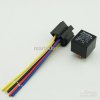BerndM
Site Supporter
- Joined
- Apr 11, 2014
- Messages
- 468
- Reaction score
- 2
- Points
- 0
- Location
- Placentia, Orange County, So Calif.
I want to make an electrical change to my 2013 DCT headlight function, and I need your collective input.
I would like to add a relay to the bike so that the headlight does not come on as soon as you turn on the key, but only after the bike has started!
I find it absolutely asinine that Honda would put a whopping 55 watt load on the poor battery in addition to the starting draw.

What I need to locate, is a connector or wire somewhere on the bike that ONLY becomes "hot" after the bike is running.
There must be something like that somewhere, I hope.
Thanks for your thoughts!
I would like to add a relay to the bike so that the headlight does not come on as soon as you turn on the key, but only after the bike has started!
I find it absolutely asinine that Honda would put a whopping 55 watt load on the poor battery in addition to the starting draw.
What I need to locate, is a connector or wire somewhere on the bike that ONLY becomes "hot" after the bike is running.
There must be something like that somewhere, I hope.
Thanks for your thoughts!








